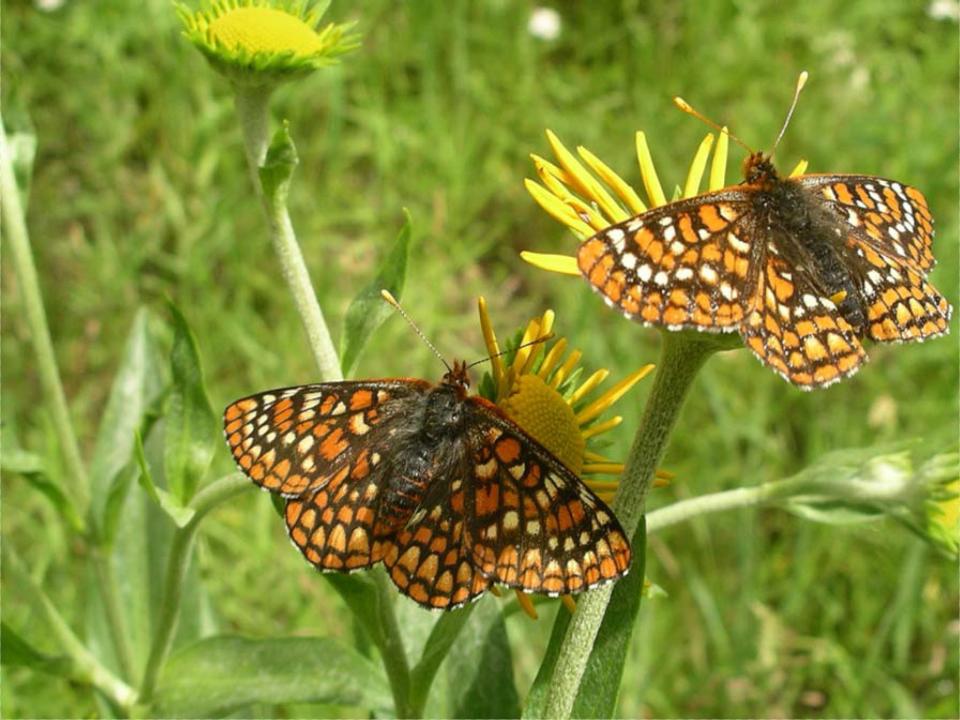Checkerspot butterfly recovery could mean setting aside lands in Lincoln National Forest
Lands within Lincoln National Forest could be set aside for recovery of the Sacramento Mountains checkerspot butterfly, which was deemed endangered by federal wildlife managers earlier this year.
The butterfly is known only to dwell in Otero County amid the Sacramento Mountains within the Lincoln National Forest in areas between 7,800 and 9,000 feet above sea level.
It was listed as endangered in March by the U.S. Fish and Wildlife Service, which cited the impacts of climate change and development on the checkerspot’s habitat, and a proposal on Wednesday would set aside 1,636 acres for recovery of the species.
More: Dunes sagebrush lizard proposed as endangered species amid threats from oil and gas
That’s made up of about 1,094 acres of land owned by the U.S. Forest Service, 521 acres of private land and another 22 acres owned by the Mescalero Apache Tribe.

A critical habitat designation does not ban development in any specific area but requires federal agencies to consult with the U.S. Fish and Wildlife Service before any such activities can occur.
The butterflies' range declined from 32 square miles around Cloudcroft, according to surveys in the 1990s, to about 2 square miles in a 2020 survey, read a report from the U.S. Fish and Wildlife Service.
More: Congress votes to cut protections for lesser prairie chicken nearly extinct in New Mexico
Threats were identified from agricultural activities like grazing, as well as recreation and invasive plant species and extreme weather events like wildfires in the area.
“This critical habitat designation identifies areas that are particularly important to the conservation of this butterfly, where actions of federal agencies or activities that require a federal permit or funding must be analyzed to prevent adverse modification of their habitat,” read a statement from the Service.
The habitat proposal was submitted to the federal register, opening a 60-day public comment period.
More: Rare Pecos River fish included in federal settlement. Protections could come next year
But previous delays on the listing decision and federal recovery efforts have already further imperiled the species, said Michael Robinson, New Mexico-based senior conservation advocate at the Center for Biological Diversity.
He said conservation tactics would need to be swift as the butterfly neared extinction.
The Center first petitioned the Fish and Wildlife Service to list the checkerspot butterfly in 1999 and it was proposed for protection, but the Service withdrew its proposal in 2004, citing voluntary conservation measures taken by landowners.
More: Are pecans driving New Mexico's drought? Heat, lack of rain predicted in coming weeks
A second petition in 2007 was denied, but the species was ultimately protected this year after a third petition by the Center.
About 10 percent of insects and 20 percent of butterflies are at risk of extinction, the Center estimated
“These beautiful and irreplaceable butterflies are barely clinging to existence because of bad decisions by the U.S. Fish and Wildlife Service,” Robinson said. “I’m so glad they’re finally getting protection for their habitat. I hope it’s not too late.”
More: Lesser prairie chicken could see protections via renewable energy projects in New Mexico
In public comments submitted amid the latest proposal, the New Mexico Department of Agriculture contended current grazing allotments were “compatible” with the butterfly’s survival, arguing there were no allotments in areas occupied by the species.
“Although the potential for impacts to the butterfly exists, our review found no information indicating that livestock grazing significantly affects the butterfly’s status now or will do so in the foreseeable future,” read the comments. “Therefore, we conclude that livestock grazing is not a signification threat to the butterfly.”
New Mexico Cattle Growers Association President Loren Patterson in his comments opposed the listing, arguing the federal government should instead focus on its own policies to mitigate the impacts of climate change, rather than implementing additional restrictions on land use.
More: Feds sued over 'inaction' to protect Peñasco least chipmunk from extinction in New Mexico
Patterson wrote that the Service acknowledged there weren’t any federal grazing allotments, pointing to the impacts of overgrazing by feral horses and elk and questioning why land managers did not control these populations to protect the butterfly in the past.
“Rather than now listing the butterfly as endangered, the (U.S. Fish and Wildlife) Service should have spent some portion of the past twenty years holding the Forest Service and the New Mexico Game and Fish Department accountable for their inaction,” Patterson wrote.
He said the listing and critical habitat designation could impede the operations of cattle ranchers in the area, as it would set aside lands beyond the species’ present range where grazing was occurring.
“To the extent that the Service proposes critical habitat that does include pastures where cattle graze, cattle growers in those areas will be harmed by this listing,” Patterson wrote. “The listing does not comport with any notion of environmental justice for the cattle growers who work to feed our nation and the world.”
Adrian Hedden can be reached at 575-628-5516, achedden@currentargus.com or @AdrianHedden on Twitter.
This article originally appeared on Carlsbad Current-Argus: Lincoln National Forest land being set aside to recover rare butterfly

